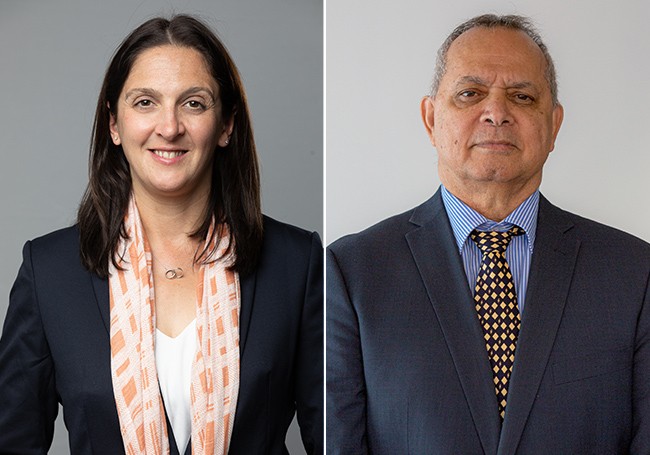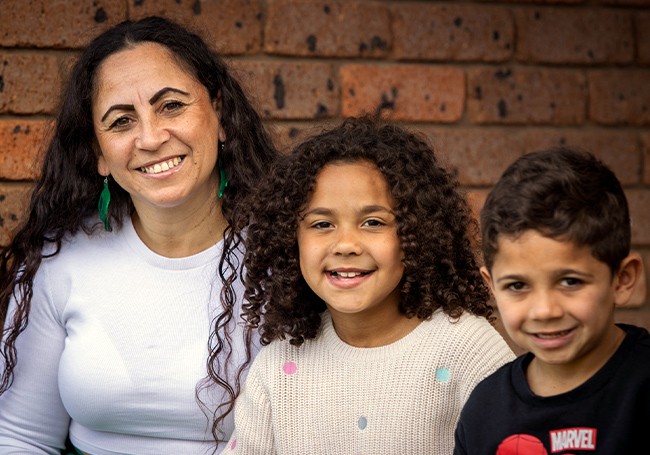Above: IBA home loan customer Amy and her family.
Home ownership. For many First Nations Australians, it’s a dream which will only ever remain out of reach and a remote fantasy. But for 21,000 owner-occupier Indigenous families and individuals, it’s an idea which has at last actually transformed into reality, due to powerful activities by federal agency Indigenous Business Australia (IBA).
“Roughly, we are nearing 5,000 home loans nationally at this point in time,” IBA CEO Kirsty Moore GAICD told the AICD in a recent interview in Perth. “And we continue to have very, very strong demand.
“The Indigenous home ownership program is the longest running program in the Indigenous affairs portfolio and it's been around for almost 50 years.”
According to the 2021 census, only 41 per cent of First Nations people own their own homes, compared to 66 per cent of non-First Nations people. “So there's a gap,” says Moore. It's a real gap in home ownership. For as long as that gap exists, IBA will need to play a role in in providing that finance where the mainstream banks won't.
“The need for that finance isn't just the fact that our customers live in maybe regional and remote areas where banks do not lend… but it's also because they don't have the bank of Mum and Dad. They don't have that intergenerational asset to support them. And they don't necessarily have role models in their community to look at - people who've owned a property.”
IBA also finances First Nations businesses. These range from small businesses such as Kakadu Kitchen, a non-alcoholic drinks entity with a store in Humpty Doo, and Mack Construction NT, a design and construction service, through to bigger enterprises such as the Centre for Appropriate Technology in Alice Springs, Warialda Engineering and Welding based in NSW, and Wilpena Pound Resort in the Flinders Ranges in South Australia.
IBA has also invested in building a new cucumber farm in Geraldton, Western Australia, and greenhouses are currently being constructed, according to Moore. “It’s part of a native title settlement with the state of Western Australia and we have had some extensive investment into that. The intent is that it will become Australia's largest cucumber farm.”
IBA is working with First Nations organisations across Australia and has joined forces with Export Finance Australia to empower First Nations companies to build their capacity to enter international markets.
IBA has an investment pipeline manages a portfolio of co-investments with Indigenous organisations valued at over $500 million, including direct investments, managed funds and a real estate investment trust. According to the IBA 2023-2024 Corporate Plan, IBA currently has $2 billion in net assets, which it aims to grow to $2.5 billion by 2028.
IBA Chair Eddie Fry, a Dagoman-Wardaman man from the Katherine region in the Northern Territory, told the AICD that IBA has already doubled net assets from $1.15 billion in 2014 to around $2 billion now. “We have cleaned up a lot of non-performing assets and we also have a board that clearly understands the commercial marketplace,” he said.
“We got smarter at doing business. In 2017, we made a massive leap from about 450 home loans to about over 900 in that one year.”
Management culture has also changed both at board level and at the operational level and offices such as the ACT have been downsized. “I would suggest we've taken on a greater corporate and operational approach than we used to have.”
The future
Over the next five years, IBA will facilitate new investment opportunities and new partnership arrangements to increase wealth and assets. It has boosted this work through recent partnership activity with the Northern Australian Infrastructure Facility (NAIF), Housing Australia, and Export Finance Australia (EFA), and in strategic banking partnerships with Australian Unity and Bank Australia.
According to the 2021 national census, there are now nearly one million First Nations people in Australia. The population of Aboriginal and Torres Strait Islander people now sits at around 984,000.
However, high interest rates and high property prices are making home ownership a more difficult proposition for many First Nations people.
“I think a big challenge going forward is to see how IBA can exceed what market conditions are currently determining. In the previous two years, house prices have just skyrocketed. Therefore, that’s going to impact on the ability of our buyers to borrow,” says Fry.
Because first homebuyers are struggling to find properties to purchase, IBA launched in August a shared equity program, which combines a finance option with an IBA home loan. The borrowing capacity of customers is increased, so they do not need to buy smaller properties than they need. “They still borrow the same amount, but by IBA putting in an equity contribution, the customer can hopefully buy a more appropriate home in a better location, with proximity to amenity and family, community in particular,” says Moore.
She says the focus on regional areas is important. Over 60 per cent of the home loan book of IBA is in regional Australia, mostly Queensland and NSW, she says. About 10 per cent is in remote areas, mainly in the Northern Territory and Western Australia.
“That's where the IBA business investment activity comes in, because we believe that if we can create local economic development, that will create opportunities for people ultimately to take control of their own futures.
“We know that home ownership provides security. A roof over your head. We also know this concept of passing assets onto kids really resonates strongly with our customer base, who want to give their kids a bright future. So they want to own a home, and they want to pass on the home. They want those kids to know that they can lay their roots in that place.”
She says IBA is governed by federal legislation and is obliged to make sustainable investment decisions to ensure that when lending to customers, the risks of ultimate financial losses are minimised through good customer support and sensible lending decisions in the first place.
“It is the IBA support which is the bit that creates success,” says Moore. “So it's the support around readiness to enter into that financial commitment in the first place. And making sure that if somebody is going to buy a house, they really understand the obligations of home ownership, that they really understand what it will mean and how they're going to withstand certain pitfalls that might come – that they have financial literacy. We support them through the customer journey for the entire length of the loan.”
UK-born Moore became CEO of IBA in May 2021, after starting as IBA Head of Products and Markets in early 2018. Driven by a passion to help people who need support, she has lived experience of difficulty with home ownership and brings this understanding to her role.
“I think part of my motivation is the fact that I come from disadvantage myself. My family come from a social housing background in the UK and I understand about opportunity. So, for me, I really want to support a cohort of society that needs assistance. It’s really as simple as that.”
Role of the board
The IBA board is composed of majority First Nations members alongside non-Indigenous members – all with business expertise. “Our board understands our customer base, so they understand some of the challenges that sit in community, they understand some of the issues of intergenerational trauma and they understand the concept of a proper fair go,” says Moore.
“They don't want IBA to be purely giving handouts. They want IBA to be investing with people who are ready to actually have a bit of gumption and go forward and take control of their own economic future.”
The board is also heavily focussed on cyber security and in 2021 created an IT subcommittee. “This is a new thing that we put in place a couple years ago in response to the need to make sure technology starts at the board level. It recognises that we do need to have modern day banking systems, and appropriate data protection in place,” she says.
The board has also driven and monitored a significant digital transformation to update IT and core business systems. “We went from having quite old-fashioned IT systems to being on the cusp of having a modern-day banking system that is used by mainstream financial services institutions. The board has supported the organisation to do that and played an active role in the oversight of that initiative.”
The board is very engaged on the subject of cyber security, inquisitive and keen to understand it, she says. “They're definitely not passive when it comes to technology and implications of cyber and customer protection in general.
“Remember that we are here not only to deal with very sensitive information pertaining to the most disadvantaged but there's also a reputational risk to the Commonwealth government, if we get it wrong.”

CEO Kirsty Moore GAICD and IBA Chair Eddie Fry

IBA home loan customer Nikea and her children.
Latest news
Already a member?
Login to view this content


